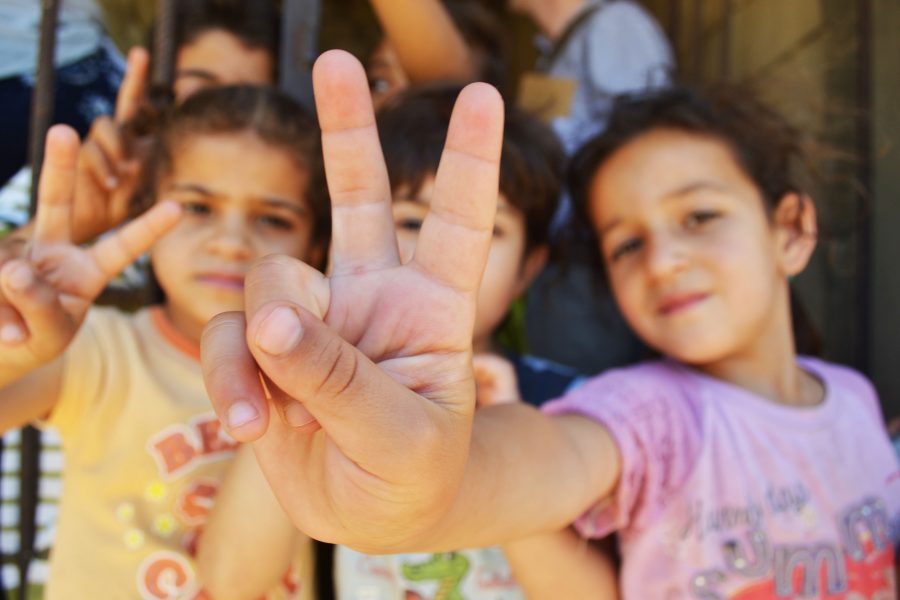Benefits and setbacks of Syrian refugees in Germany
Photo by Trocaire, published on June 25, 2013, Some rights reserved, license link: https://creativecommons.org/licenses/by/2.0/, original link to work: https://www.flickr.com/photos/trocaire/9362333059/in/photolist-fgjprv-jqDpeh-fSi4Ec-mC4uCp-fSh5Y8-o5YHGf-fShAzb-ddQBiM-mC7xbe-s1rtmq-fSgwjg-pxryNR-fSgPJa-j6yxi9-yJY2oK-brWdxb-yJY4dg-J47u4f-dQotuS-nRAmXo-p1rLZH-eq12gH-fSfEqE-rwvztb-fSh2ZJ-fShX7y-fA4Erg-s1yj6M-kfPA1Z-mC85wZ-nzffww-jx5wLC-o2tzGf-fAiYf5-hj9Pu3-ePqstQ-raGHzr-eVcrvk-fSgJCD-mC87aZ-o2inNV-i2ph1f-rmcYPH-fSh5Sq-jqC7iA-fA4DKH-eVoNG5-hWi6nT-fAiYFw-kfRkqU Young Syrian immigrants hold up a peace sign.
In September of 2015, Chancellor of Germany Angela Merkel invited Syrian refugees to seek asylum in Germany. By late 2016, nearly 600,000 of these refugees had entered Germany to escape the Civil War in their own country. This has produced both benefits and setbacks in the country.
Of the benefits, there is an increased respect for Germany (both by allies and in the Middle East), possible increase in workforce, and a more diverse country.
Since Merkel’s decision to let in Syrian refugees, both allies and the Middle East have renewed their respect for the country and confirmed its role as a leader of the EU. Chancellor Merkel says, “Germany is doing what is morally and legally obliged. Not more, and not less.”
The benefit of an increased workforce comes from the fact that most of the refugees fall under a certain demographic: 25 years old and younger. This allows for a workforce that can be easily trained and educated. The benefits of this are predicted to be shown within the next 10-25 years, with new foreign workers replacing retiring German ones.
The cost for a single refugee is $12,000 a year with $152 to settle themselves in their new country. Though this may sound costly, the total cost of refugees (about 10 billion euros) is only .3% of the country’s GDP demonstrating that the benefits in the future outweigh the current costs.
There are, of course, setbacks that include problems with assimilation and concerns on decreased security.
While an increased workforce is the ideal scenario, the actual reality is still working towards that. The assimilation into the job market is estimated to take 15 years. As of 2015, 30,000 of 297,000 refugees seeking jobs got them.
By September 2016, however, only 54 found jobs within Germany’s top 30 companies (with 50 of them working at postal company, Deutsche Post). Most work low-paying jobs in restaurants, construction sites, or bakeries.
Though there are many vacancies for jobs, including 660,000 open jobs in automobile company Daimler, refugees often lack skills required to do the job and the ability to speak German.
However, new laws in Germany are now helping with refugees’ integration into society. Those seeking asylum must take classes regarding Germany’s history, culture, and language. Employers are obligated to not give preference between native German and immigrant workers.
Another problem is decreased security due to the influx of immigrants. Even one of Germany’s allies, China, has expressed their concern. This concern is worsened with Islamic-related attacks that caused both fear and resentment in regards to the openness to refugees.
These attacks included a 27-year-old Syrian suicide bombing in Bavaria, a 17-year-old Afghan teen seeking asylum who attacked train passengers with an axe, and a 21-year-old Syrian refugee who killed a woman and injured five people with a machete.
The most recent attack was six days before Christmas, in which a man drove a trailer truck into a Christmas market in Berlin.
These attacks, along with similar ones in France, have not only spread fear and uneasiness, but lowered Angela Merkel’s ratings. Though her approval rating was 63% midway through 2015, it now rests at 45%.
Though the situation remains apprehensive as of now, only time will be able to tell how it pans out. Until then, Germany has two main challenges concerning Syrian refugees in its way: security concerning any attacks and the uncertainty of the future of the refugees.
Your donation will help support The Lambert Post, Lambert High Schools student-run newspaper! Your contribution will allow us to purchase equipment and cover website hosting costs.








